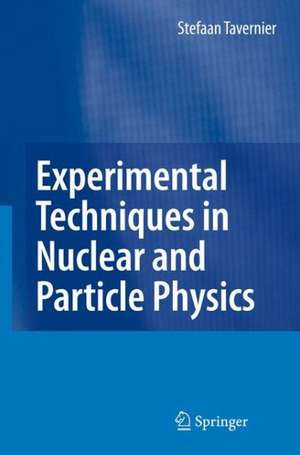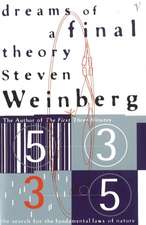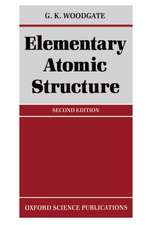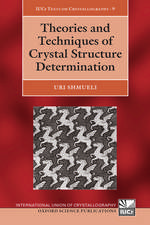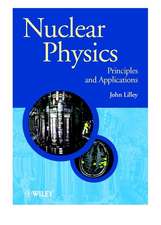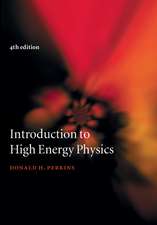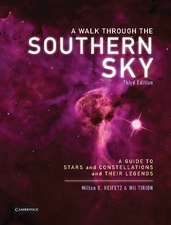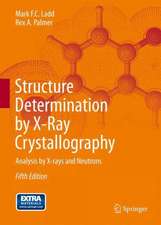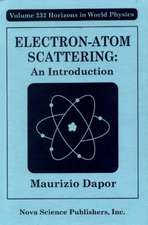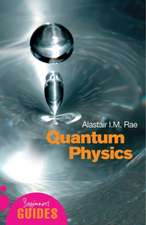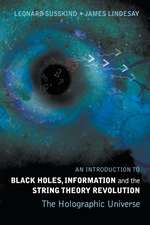Experimental Techniques in Nuclear and Particle Physics
Autor Stefaan Tavernieren Limba Engleză Hardback – 25 feb 2010
| Toate formatele și edițiile | Preț | Express |
|---|---|---|
| Paperback (1) | 389.31 lei 6-8 săpt. | |
| Springer Berlin, Heidelberg – 22 noi 2014 | 389.31 lei 6-8 săpt. | |
| Hardback (1) | 407.51 lei 39-44 zile | |
| Springer Berlin, Heidelberg – 25 feb 2010 | 407.51 lei 39-44 zile |
Preț: 407.51 lei
Preț vechi: 503.10 lei
-19% Nou
Puncte Express: 611
Preț estimativ în valută:
77.98€ • 83.38$ • 65.02£
77.98€ • 83.38$ • 65.02£
Carte tipărită la comandă
Livrare economică 14-19 aprilie
Preluare comenzi: 021 569.72.76
Specificații
ISBN-13: 9783642008283
ISBN-10: 3642008283
Pagini: 316
Ilustrații: X, 306 p.
Dimensiuni: 155 x 235 x 25 mm
Greutate: 0.59 kg
Ediția:2010
Editura: Springer Berlin, Heidelberg
Colecția Springer
Locul publicării:Berlin, Heidelberg, Germany
ISBN-10: 3642008283
Pagini: 316
Ilustrații: X, 306 p.
Dimensiuni: 155 x 235 x 25 mm
Greutate: 0.59 kg
Ediția:2010
Editura: Springer Berlin, Heidelberg
Colecția Springer
Locul publicării:Berlin, Heidelberg, Germany
Public țintă
GraduateDescriere
I have been teaching courses on experimental techniques in nuclear and particle physics to master students in physics and in engineering for many years. This book grew out of the lecture notes I made for these students. The physics and engineering students have rather different expectations of what such a course should be like. I hope that I have nevertheless managed to write a book that can satisfy the needs of these different target audiences. The lectures themselves, of course, need to be adapted to the needs of each group of students. An engineering student will not qu- tion a statement like “the velocity of the electrons in atoms is ?1% of the velocity of light”, a physics student will. Regarding units, I have written factors h and c explicitly in all equations throughout the book. For physics students it would be preferable to use the convention that is common in physics and omit these constants in the equations, but that would probably be confusing for the engineering students. Physics students tend to be more interested in theoretical physics courses. However, physics is an experimental science and physics students should und- stand how experiments work, and be able to make experiments work.
Cuprins
Interactions of Particles in Matter.- Natural and Man-Made Sources of Radiation.- Detectors Based on Ionisation in Gases.- Detectors Based on Ionisation in Semiconductor Materials.- Detectors Based on Scintillation.- Neutron Detection.- Electronics for Particle Detectors.
Textul de pe ultima copertă
The book is based on a course in nuclear and particle physics that the author has taught over many years to physics students, students in nuclear engineering and students in biomedical engineering. It provides the basic understanding that any student or researcher using such instruments and techniques should have about the subject.
After an introduction to the structure of matter at the subatomic scale, it covers the experimental aspects of nuclear and particle physics. Ideally complementing a theoretically-oriented textbook on nuclear physics and/or particle physics, it introduces the reader to the different techniques used in nuclear and particle physics to accelerate particles and to measurement techniques (detectors) in nuclear and particle physics.
The main subjects treated are: interactions of subatomic particles in matter; particle accelerators; basics of different types of detectors; and nuclear electronics. The book will be of interest to undergraduates, graduates and researchers in both particle and nuclear physics. For the physicists it is a good introduction to all experimental aspects of nuclear and particle physics. Nuclear engineers will appreciate the nuclear measurement techniques, while biomedical engineers can learn about measuring ionising radiation, the use of accelerators for radiotherapy. What’s more, worked examples, end-of-chapter exercises, and appendices with key constants, properties and relationships supplement the textual material.
After an introduction to the structure of matter at the subatomic scale, it covers the experimental aspects of nuclear and particle physics. Ideally complementing a theoretically-oriented textbook on nuclear physics and/or particle physics, it introduces the reader to the different techniques used in nuclear and particle physics to accelerate particles and to measurement techniques (detectors) in nuclear and particle physics.
The main subjects treated are: interactions of subatomic particles in matter; particle accelerators; basics of different types of detectors; and nuclear electronics. The book will be of interest to undergraduates, graduates and researchers in both particle and nuclear physics. For the physicists it is a good introduction to all experimental aspects of nuclear and particle physics. Nuclear engineers will appreciate the nuclear measurement techniques, while biomedical engineers can learn about measuring ionising radiation, the use of accelerators for radiotherapy. What’s more, worked examples, end-of-chapter exercises, and appendices with key constants, properties and relationships supplement the textual material.
Caracteristici
This book is open access, which means that you have free and unlimited access.
Interdisciplinary approach to particle techniques and accelerators, suitable for all fields (nuclear and particle physics, and nuclear and biomedical engineering)
Interdisciplinary approach to particle techniques and accelerators, suitable for all fields (nuclear and particle physics, and nuclear and biomedical engineering)
